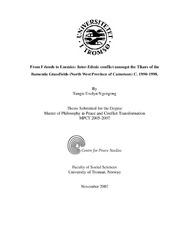| dc.contributor.advisor | Randi, Rønning Balsvik | |
| dc.contributor.author | Tangie, Evelyn Ngengong | |
| dc.date.accessioned | 2008-01-23T11:48:08Z | |
| dc.date.available | 2008-01-23T11:48:08Z | |
| dc.date.issued | 2007-11-01 | |
| dc.description.abstract | Ethnic conflicts in the Bamenda grassfields became common occurrences at the advent of the Chamba raids in the 1820s. Despite the presence of such conflicts, few scholarly works have been done. This lack of material provided a motivation for this study – “From Friends to Enemies: Inter-Ethnic conflict amongst the Tikars of the Bamenda Grassfields (North West Province of Cameroon) C. 1950-1998”.
The endeavour is to show how these ethnic conflicts can be considered a product of fast degenerating arable land against the background of fast growing population; the Bambili / Babanki-tungoh ethnic conflict is the product of centralized state building process in the Bamenda grassfields and it is fostered by economic imperatives. It is to fill the gap in Bamenda grassfield’s historiography.
In order to investigate these hypotheses answers have been sought for the following questions:
why is the Bamenda Grassfields rife with many ethnic conflicts in general and the Bambili/Babanki-tungoh in particular? What makes the two ethnic groups different, so much so that they fight each other over a piece of land? Who are the motivators of the ethnic conflict in the area? Of what importance is the disputed land between the two contestants under study? What attempts have been made by the traditional government and civil administration to end these conflicts and why have these attempts not bore any fruits?
It is evident from this study that ethnic conflicts in the Bamenda grassfields are as a result of an ever growing population without a corresponding increase in land. It also shows that the ethnic conflicts are as a result of the ever empire state building in the sub region. Furthermore, it is also evident from the work that economic consideration over the fertile piece of land between the two villages is the main cause of the ethnic conflict between Bambili and Babanki-tungoh. The claims of the two villages over the disputed land are not authentic. This is because none of the villages are willing to show a land certificate which could make the piece of land to be conveniently theirs. It is also evident that the Bambili and Babanki-tungoh have similarities (Tikars) but the ethnic conflicts have made them different from each other. | en |
| dc.format.extent | 2074 bytes | |
| dc.format.extent | 1766981 bytes | |
| dc.format.mimetype | text/plain | |
| dc.format.mimetype | application/pdf | |
| dc.identifier.uri | https://hdl.handle.net/10037/1314 | |
| dc.identifier.urn | URN:NBN:no-uit_munin_1102 | |
| dc.language.iso | eng | en |
| dc.publisher | Universitetet i Tromsø | en |
| dc.publisher | University of Tromsø | en |
| dc.rights.accessRights | openAccess | |
| dc.rights.holder | Copyright 2007 The Author(s) | |
| dc.subject.courseID | SVF-3901 | nor |
| dc.subject | VDP::Samfunnsvitenskap: 200::Økonomi: 210 | en |
| dc.subject | VDP::Samfunnsvitenskap: 200::Sosialantropologi: 250 | en |
| dc.subject | tanwie | en |
| dc.subject | mokura | en |
| dc.subject | afrika | en |
| dc.subject | etnisitet | en |
| dc.subject | konflikt | en |
| dc.subject | mennesker | en |
| dc.subject | økonomi | en |
| dc.subject | kamerun | en |
| dc.title | From friends to enemies : inter-ethnic conflict amongst the Tikars of the Bamenda Grassfields (North West Province of Cameroon) c. 1950-1998 | en |
| dc.type | Master thesis | en |
| dc.type | Mastergradsoppgave | en |


 English
English norsk
norsk